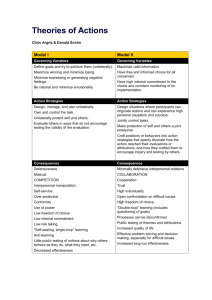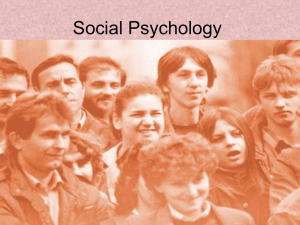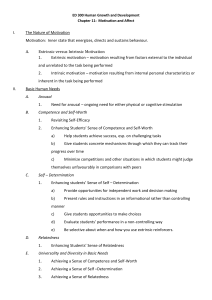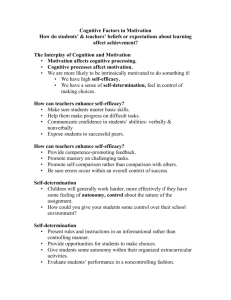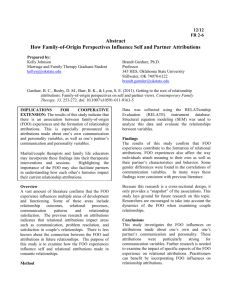Children's Attributions for Success and Failure: Effects of
advertisement
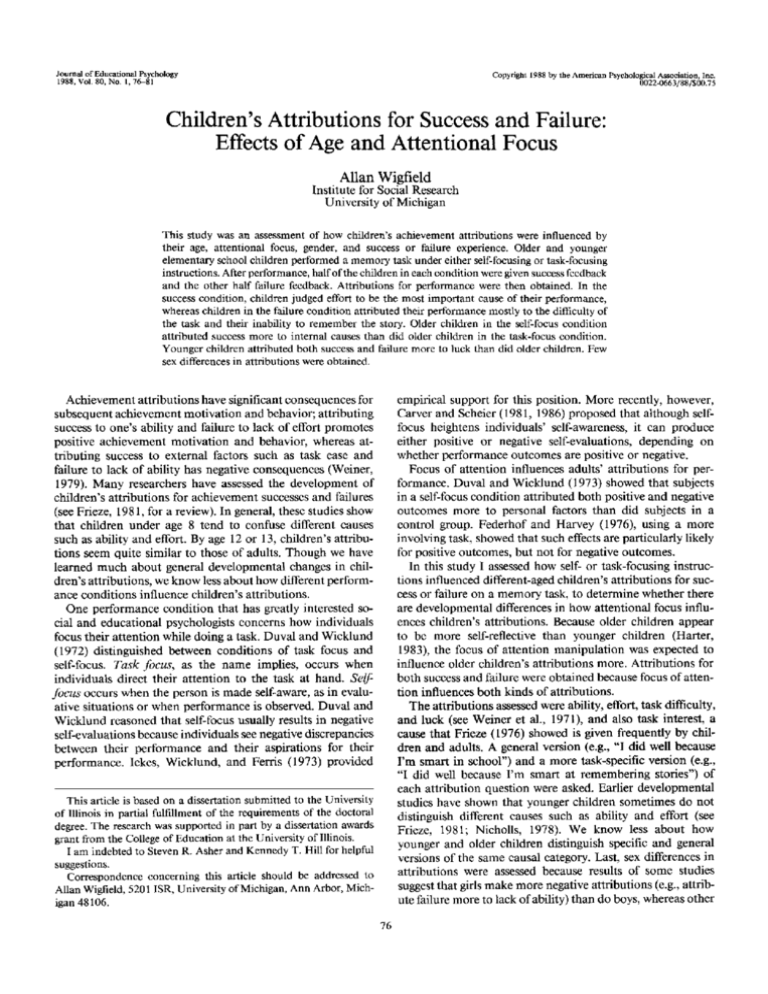
Journal of Educational Psychology
1988, Vol. 80, No. 1,76-81
Copyright 1988 by the American Psychological Association, Inc.
O022-O663/88/S0O.75
Children's Attributions for Success and Failure:
Effects of Age and Attentional Focus
Allan Wigfield
Institute for Social Research
University of Michigan
This study was an assessment of how children's achievement attributions were influenced by
their age, attentional focus, gender, and success or failure experience. Older and younger
elementary school children performed a memory task under either self-focusing or task-focusing
instructions. After performance, half of the children in each condition were given success feedback
and the other half failure feedback. Attributions for performance were then obtained. In the
success condition, children judged effort to be the most important cause of their performance,
whereas children in the failure condition attributed their performance mostly to the difficulty of
the task and their inability to remember the story. Older children in the self-focus condition
attributed success more to internal causes than did older children in the task-focus condition.
Younger children attributed both success and failure more to luck than did older children. Few
sex differences in attributions were obtained.
Achievement attributions have significant consequences for
subsequent achievement motivation and behavior; attributing
success to one's ability and failure to lack of effort promotes
positive achievement motivation and behavior, whereas attributing success to external factors such as task ease and
failure to lack of ability has negative consequences (Weiner,
1979). Many researchers have assessed the development of
children's attributions for achievement successes and failures
(see Frieze, 1981, for a review). In general, these studies show
that children under age 8 tend to confuse different causes
such as ability and effort. By age 12 or 13, children's attributions seem quite similar to those of adults. Though we have
learned much about general developmental changes in children's attributions, we know less about how different performance conditions influence children's attributions.
One performance condition that has greatly interested social and educational psychologists concerns how individuals
focus their attention while doing a task. Duval and Wicklund
(1972) distinguished between conditions of task focus and
self-focus. Task focus, as the name implies, occurs when
individuals direct their attention to the task at hand. Selffocus occurs when the person is made self-aware, as in evaluative situations or when performance is observed. Duval and
Wicklund reasoned that self-focus usually results in negative
self-evaluations because individuals see negative discrepancies
between their performance and their aspirations for their
performance. Ickes, Wicklund, and Ferris (1973) provided
empirical support for this position. More recently, however,
Carver and Scheier (1981, 1986) proposed that although selffocus heightens individuals' self-awareness, it can produce
either positive or negative self-evaluations, depending on
whether performance outcomes are positive or negative.
Focus of attention influences adults' attributions for performance. Duval and Wicklund (1973) showed that subjects
in a self-focus condition attributed both positive and negative
outcomes more to personal factors than did subjects in a
control group. Federhof and Harvey (1976), using a more
involving task, showed that such effects are particularly likely
for positive outcomes, but not for negative outcomes.
In this study I assessed how self- or task-focusing instructions influenced different-aged children's attributions for success or failure on a memory task, to determine whether there
are developmental differences in how attentional focus influences children's attributions. Because older children appear
to be more self-reflective than younger children (Harter,
1983), the focus of attention manipulation was expected to
influence older children's attributions more. Attributions for
both success and failure were obtained because focus of attention influences both kinds of attributions.
The attributions assessed were ability, effort, task difficulty,
and luck (see Weiner et al., 1971)s and also task interest, a
cause that Frieze (1976) showed is given frequently by children and adults. A general version (e.g., "I did well because
I'm smart in school") and a more task-specific version (e.g.,
"I did well because I'm smart at remembering stories") of
each attribution question were asked. Earlier developmental
studies have shown that younger children sometimes do not
distinguish different causes such as ability and effort (see
Frieze, 1981; Nicholls, 1978). We know less about how
younger and older children distinguish specific and general
versions of the same causal category. Last, sex differences in
attributions were assessed because results of some studies
suggest that girls make more negative attributions (e.g., attribute failure more to lack of ability) than do boys, whereas other
This article is based on a dissertation submitted to the University
of Illinois in partial fulfillment of the requirements of the doctoral
degree. The research was supported in part by a dissertation awards
grant from the College of Education at the University of Illinois.
I am indebted to Steven R. Asher and Kennedy T. Hill for helpful
suggestions.
Correspondence concerning this article should be addressed to
Allan Wigfield, 5201ISR, University of Michigan, Ann Arbor, Michigan 48106.
76
AGE AND ATTENTIONAL FOCUS
researchers have not obtained such differences (for further
discussion, see Dweck & Goetz, 1978; Frieze, 1981; Parsons,
Meece, Adler, & Kaczala, 1982).
On the basis of the work just reviewed, the following
predictions were made: The self-focusing instructions should
lead children to make more internal attributions, particularly
for success. The task-focusing instructions should lead children to make more external attributions, particularly for
failure. These differences were expected to be stronger for
older children. Children should attribute both success and
failure more to specific than general causes because the specific causes relate to the particular task that they were doing.
Last, children should make more internal attributions for
success and more external attributions for failure.
Method
77
(or poorly) and that they were going to rate the importance of several
different reasons for their performance. Each attribution (ability,
effort, difficulty, luck, and interest) was given separately, and a specific
version (e.g., "because you tried hard to remember the story") and a
more general version (e.g., "because you usually try hard in school")
of each question were given. The experimenter read aloud each
question and the five possible responses ("That is a very important
reason why," "That is an important reason why," etc.) and recorded
the child's responses on rating scales of 1 (very unimportant) to 5
(very important). Then children answered four other questions, one
concerned with expectations for future success, one with future choice
of easier or harder recall tasks, and one each on degree of self-focus
and degree of task focus. The experimenter read each question aloud
and recorded the children's responses on rating scales. These questions served as manipulation checks.
Children in the failure group recalled a second story. After recall,
the experimenter assured children that they had done well on this
story and that the first story was difficult for their age group.
Participants
Scoring
The 151 participants included 37 second graders, 34 third graders,
47 fifth graders, and 33 sixth graders. One child's responses to two
manipulation check questions and one attribution question were lost;
hence for those questions the sample size was 150. All children were
assigned randomly to condition; the assignment was done separately
for boys and girls. Thirty-eight children were assigned to the selffocus failure condition, 39 to the self-focus success condition, 37 to
the task-focus failure condition, and 37 to the task-focus success
condition.
Children's attributions were scored from 1 to 5; higher scores
indicated that the reason was more important. Responses to the
"expectations for future success" and "task choice" questions also
were scored from 1 to 5; higher scores indicated higher expectations
and choosing a harder task, respectively. Children's responses to the
self- and task-focus questions were scored from 1 to 4; higher scores
indicated greater self-focus and greater task focus, respectively.
Analysis
Procedure
The experimenter administered the memory task individually to
each child, in the child's school building. Each child was told that he
or she would listen to a tape-recorded story and verbally recall it and
that performance would be evaluated.
Children in the self-focus condition were then told (in accordance
with Sarason's 1972 self-focusing manipulation)
Remembering is an important thing you have to do in school,
and how well you remember the story is a good test of how well
you do in school. So, as you are listening to the story, think
about it like it is a test, like other tests you have in school that
show how well you are doing. Any questions?
In the task-focus condition, children were told (in accordance with
Brockner & Hulton's 1978 task-focusing manipulation)
Remembering stories can be kind of tricky, so I'd like you to
concentrate very hard on the story at all times; other kids have
said that this helped them as they were trying to remember. So
just keep thinking about the story as much as possible. Any
questions?
Children then completed the memory task and received the evaluative feedback. Half of the children in each condition were told that
they had recalled the story well and half that they had recalled the
story poorly. Because no child came close to achieving 100% recall,
all children appeared to believe the feedback (see Results section).
Children then made attributions for performance. They were told
that there are different possible reasons for remembering stories well
Children's responses were analyzed in analysis of variance (ANOVA)
and paired / tests. Because of the large number of possible effects, the
.01 level of significance was adopted. The four grade levels were
collapsed into a younger age group and an older age group because
there were very few differences between second- and third-grade
children's responses or between fifth- and sixth-grade children's responses. Two different ANOVAS were run. First, effects of success or
failure, attentional condition, age, and sex on the responses to the
manipulation check questions and attribution items were assessed.
For the attributions, only the main effects of success/failure and its
interactions with other factors were considered in this analysis. The
other main effects and interaction terms are not meaningful because
they involved summing over the two different kinds of attribution
questions asked, those for failure and those for success. Second, the
success and failure groups were analyzed separately in order to assess
attentional condition, age, and sex effects on the attributions. Paired
t tests were run to assess within-subject differences between specific
and general versions of each attribution and also between internal
and external attributions.
Results
Manipulation Check Questions
Children's responses to the four manipulation check questions were analyzed in a 2 x 2 x 2 X 2 (Success/Failure X
Attenlional Condition x Age x Sex) ANOVA. On the "expec-
78
ALLAN WIGFIELD
tations for future success" question, children in the success
group (M = 3.91) had higher expectations for future performance than did children in the failure group (M = 3.29), F(l,
135) = 19.34, p < .01. Similarly, on the "task choice" question, children in the success group {M = 3.58) stated that they
would prefer to do a harder task in the future than did children
in the failure group (M = 2.88), F(l, 135) = 23.51, p < ,01.
These results show that the success/failure manipulation had
its desired effects. No other significant effects were observed
on these questions.
On the "degree of self-focus question," children in the selffocus condition (M = 3.00) reported focusing more on themselves than did children in the task-focus condition (M —
2.64), and the effect was nearly significant, F(\, 134) = 6.16,
p = .014. On the "degree of task focus" question, there were
no differences between the conditions; the means on this
question tended to be quite high. However, younger children
(M = 3.89) reported focusing more on the task than did older
children {M = 3.59), F(l, 134) = 9.82, p < .01. No other
significant effects were observed on these questions.
Children's
Attributions
Success/failure effects. Significant main effects for success/failure were obtained on all but the two luck questions
and the specific difficulty question. The means are presented
in Table 1. For each significant difference, the means of the
success group were higher, indicating that children in the
success group endorsed the reason more strongly.
The interaction of Success/Failure x Condition x Age on
the specific ability question was significant, F( 1, 135) = 7.96,
p < .01; the means are presented in Table 2. Older children
attributed success more to ability in the self-focus condition
than in the task-focus condition, and they attributed failure
to lack of ability similarly across conditions. Younger children
Table 1
Means, Standard Deviations, and Univariate F Test Results
for the Success and Failure Groups on
the Attribution Questions
Success
group
(« == 76)
Failure
group
(« == 75)
Attribution
M
SD
M
SD
MSE
F ( l , 135)
Specific ability
General ability
Specific effort
General effort6
Specific difficulty
General difficulty
Specific luck
General luck
Specific interest
General interest
3.57
3.55
4.43
3.92
0.87
1.14
0.88
1.13
3.21
2.56
2.13
1.84
1.05
1.04
1.27
1.10
0.71
1.47
0.81
1.14
4.92*
32.52**
169.97**
130.47**
3.59
1.12
3.36
1.16
1.09
1.59
2.92
2.24
2.28
3.92
3.53
1.13
1.47
1.33
1.15
1.29
2.29
2.36
2.07
2.73
1.87
1.23
1.44
1.35
1.29
1.11
1.63
1.76
1.29
1.41
1.61
8.88**
0.69
0.74
33.85**
74.91**
Note. Scores range from 1 to 5; higher scores indicated that the reason
was rated more highly.
11
n = 74; .Ftest djs were 1, 134.
*/>< .05. * * / ; < . 0 1 .
Table 2
Means and Standard Deviations for the Specific Ability
Question as a Function ofSuccess/Failure,
Condition, and Age
Age
Younger
Condition
Success
Self-focus
Task focus
Failure
Self-focus
Task focus
Older
n
M
SD
n
M
SD
18
19
3.22
3.68
0.94
0.75
21
18
3.86
3.44
0.79
0.92
18
16
3.67
3.13
1.03
i.09
20
21
2.95
3.14
1.19
0.85
credited success more to their ability in the task-focus condition than in the self-focus condition, and they attributed
failure more to lack of ability in the self-focus condition than
in the task-focus condition. This interaction supported the
prediction that the self-focus manipulation would influence
older children's internal attributions for success more than
younger children's. No other significant interactions of success/failure with other effects were observed.
Paired t tests were run on the means of each pair of internal
and external attributions (ability-difficulty, ability-luck, effort-difficulty, effort-luck, interest-difficulty, and interestluck) to determine whether children made more internal or
external attributions following success or failure. In the success group, five of the six comparisons were significant (ps <
.01), and allfiveshowed that children attributed success more
to internal factors. The only nonsignificant comparison was
between specific ability and specific difficulty. For the general
attributions, all six comparisons were significant (ps < .01),
and all showed that children made more internal attributions
for success.
In the failure group, for both the specific and general
attributions, two of the comparisons showed that children
attributed failure more to external factors (difficulty vs. effort,
difficulty vs. interest), and one showed that children made
more internal attributions for failure (ability vs. luck; all ps <
.01). The other three comparisons were not significant.
Condition differences. As mentioned earlier, the success
and failure groups also were analyzed separately in 2 x 2 x 2
(Attentional Condition x Age x Sex) ANOVAS because of the
different kinds of attribution questions. There were no main
effects for condition in either the success or failure group.
Three interactions of condition with other factors emerged,
and the means and standard deviations are presented in Table
3. On the general ability question, the Condition x Sex
interaction was significant, F(i, 68) = 6.79, p = .01. This
interaction indicated that girls attributed success more to
ability in the task-focus condition than in the self-focus condition, whereas boys did just the opposite. On the general
effort question, the Condition X Age interaction was significant, F(l, 68) = 6.74, p - .01. Older children attributed
success more to general effort in the self-focus condition than
in the task-focus condition, whereas younger children's attributions were quite similar in both conditions. On the general
79
AGE AND ATTENT1ONAL FOCUS
Table 3
Means and Standard Deviations for the Two-Way
Interactions on the Attribution Questions: Success Condition
Self-focus
Attribution
General ability
Female
Male
General effort
Younger
Older
General interest
Younger
Older
Task focus
n
M
SD
n
M
SD
18
21
3.06
3.62
1.11
0.97
18
19
4.17
3.37
1.15
1.12
18
21
4.00
4.10
1.14
1.14
19
18
4.37
3.17
0.76
1.15
18
21
3.39
3.81
1.33
1.11
19
18
3.89
2.94
1.15
1.35
interest question, the Condition x Age interaction was nearly
significant, F( 1, 68) = 5.95, p = .02. Older children attributed
success more to general interest in the self-focus condition,
whereas the opposite pattern occurred for younger children.
Age differences. Age main effects occurred on several of
the attribution questions. Older children (M= 3.90) attributed
success more to task ease than did younger children (M =
3.27), F(\, 68) = 6.29, p = .01. On the specific and general
luck questions, younger children (Ms = 2.97 for specific luck,
3.00 for general luck) attributed success more to luck than
did older children (Ms = 1.54 for specific luck, 1.59 for
general luck); each age effect was highly significant, F(l, 68)
= 21.69, p < .01, for specific luck and F(U 68) = 29.49, p <
.01, for general luck. Similarly, younger children attributed
failure more to luck on both the specific and general questions
(Ms = 3.29 for specific luck, 3.03 for general luck) than did
older children (Ms = 1.59 for specific luck, 1.27 for general
luck); again, each age effect was highly significant, F(\, 67) =
36.10, p< .01, for specific luck and f[l, 67) = 50.91, p <
.01, for general luck.
General versus specific attributions. Paired / tests were
performed on the means of the specific and general attributions (see Table 1 for the means) with separate analyses for
success and failure groups. In the success group, children's
ratings for specific effect, difficulty, and interest were significantly higher than their ratings of general effort, difficulty,
and interest (all p$ < .01). In the failure group, children
attributed failure significantly more to the specific version
than to the general version of each attribution (all ps < .01).
These results support the hypothesis that children would rate
the specific attributions as more important than the general
attributions.
These analyses also were performed separately for the
younger and older groups. For the younger group, the only
differences were in the failure condition. Children rated specific ability and difficulty as more important reasons for
failure than general ability and difficulty (both ps < .01). For
the older group, results exactly paralleled those for the whole
sample. These analyses indicate that older children distinguished more between the specific and general versions of the
attributions than did the younger children.
Sex differences. Few significant sex differences in attributions were obtained. Boys (M = 3.88) attributed success
more to task ease than did girls (M = 3.18), and the effect
was nearly significant, F(\, 68) = 5.76, p < .02. Boys (M =
2.14) also attributed failure more to lack of general interest in
school than did girls {M = 1.61), F(l, 68) = 6.96, p = .01,
though neither group rated this attribution very highly.
Discussion
Results of this study show that children's attributions varied, depending on the conditions under which they were
made. Success or failure experience had the strongest impact.
In the success condition, children judged effort (particularly
task specific effort) to be the most important cause of their
performance, as found in other studies (Harari & Covington,
1981; Parsons et al., 1982). Because effort is observable, it
may be easier for children to judge their level of effort, and
so they emphasize effort when explaining success. Ability,
interest, and task ease were all rated as moderately important
reasons for success, though there were some changes in the
ordering of their importance across specific and general categories. Luck was judged to be less important, especially by
older children. The paired comparisons of internal and external attributions showed that as predicted, children emphasized
internal causes (effort, ability, and interest) to explain success,
as has been found in other studies (Miller & Ross, 1975;
Whitley & Frieze, 1985).
In the failure condition, only task-specific ability and taskspecific difficulty were judged as somewhat important causes
of failure, and the paired comparisons of internal and external
attributions showed fewer differences. These results (which
are contrary to predictions) are dissimilar to those of studies
showing that adults deny responsibility for failure by attributing it more to external causes (Miller & Ross, 1975). However, they are similar to findings reported by Harter (1985)
that many elementary school-aged children take some responsibility for their failures. As suggested by Harter, perhaps
children do not engage as much as adults do in the egoprotective strategy of attributing failure to external causes.
Children in the failure condition also did not endorse lack
of effort as an important reason for failure. Frieze, Snyder,
and Fontaine (1978) obtained similar results with children,
but studies with adults often show that they prefer to attribute
failure to lack of effort rather than to lack of ability (e.g.,
Covington & Omelich, 1979). Indeed, according to self-worth
theory (Covington, 1984), students try to maintain self-worth
by attributing failure to lack of effort. This may be possible
when students are working individually without much supervision. However, when student's performance is closely monitored, as it was in this study and may be in many classrooms,
attributing failure to lack of effort may not be plausible. In
such situations, students must adopt other strategies to maintain self-worth in the face of failure.
What might such strategies be? Other results reported here
showed that students attributed failure more to task-specific
causes (e.g., poor recall ability) than to their general characteristics (e.g., low ability in school). This strategy should limit
failure's impact on students' general self-concepts (see Abramson, Seligman, & Teasdale, 1978). Older children made the
80
ALLAN WIGFIELD
specific-general distinction more than did younger children,
which suggests that they may be adopting this self-worth
maintenance strategy more.
The attentional focus manipulation was partly successful,
as indicated by children's responses to the "degree of selffocus" question. However, all children indicated a high level
of task focus. Perhaps telling children that they were going to
be evaluated made them all think it important to focus on
the task. In future studies researchers should attempt to
manipulate task focus without including evaluative instructions.
The effects of the attentional focus manipulation on children's attributions provided support for some of the hypotheses, but not for others. In regard to failure, as predicted,
children in the task-focus condition attributed failure more to
task difficulty than did children in the self-focus condition,
though this effect was only marginally significant. This finding
suggests that task focus may allow children to interpret failure
more positively by attributing it to an external cause (see
Weiner, 1979).
In the success condition, there were no main effects associated with attentional condition. However, the interactions
of success/failure, condition, and age on the specific ability
question and of condition and age on the general effort and
general interest questions all showed that older children in
the self-focus condition made more internal attributions for
success than did the older children in the task-focus condition
and the younger children in the self-focus condition. These
results support the prediction that self-focus would foster
internal attributions more for older children than for younger
children, though the fact that these interactions did not occur
on all the internal attributions qualifies their strength. They
also support Carver and Scheier's (1981, 1986) and Fcdcrhof
and Harvey's (1976) contention that self-focus heightens positive self-evaluations after success.
Though attributing success to internal causes generally is
viewed as positive (Weiner, 1979), promoting self-focus may
not be the best way to increase internal attributions for
success. As students move through school, there is an increasing emphasis on evaluation, competition, and social comparison, which may increase students' tendency to focus on how
they are doing rather than on mastering material (see Eccles,
Midgley, & Adler, 1984). This increase in self-focus should
pose few motivational problems for students who continue to
do well, but for those doing less well, it may lead to the
negative discrepancy between level of performance and aspirations that Duval and Wicklund (1972) discussed, resulting
in negative self-evaluations and possible decreases in student
motivation. Future researchers could assess the effects of selfand task focus on children's attributions and motivation
during the secondary school years to test these possibilities.
For younger children, the attentional focus manipulation
produced some findings opposite to predictions; younger children made more internal attributions for success in the taskfocus condition (on the specific ability, general effort, and
general interest questions), and attributed failure more to lack
of specific ability in the self-focus condition. Younger children
tend to be less self-reflective than older children (Harter,
1983). They also may not distinguish between different causal
categories in the same way that older children do (Nicholls,
1978). Thus for the younger children, the self-focus instructions may not have promoted the ego-enhancing pattern of
attributing success to internal attributions found in the older
children (and adults in other studies) or the more ego-protective strategy of not attributing failure to lack of ability. Future
researchers could more fully explore third- through fifth-grade
children's attributions to determine when self-focusing instructions begin to increase internal attributions for success.
Also, in such studies researchers could examine how children's
self-esteem might interact with attentional focus (and age) to
influence attributions, insofar as Brockner and Hulton's
(1978) work with adults shows that the effects of attentional
focus differ for individuals with high or low self-esteem.
Younger and older children's attributions differed in several
other ways. Older children attributed success more to task
ease, probably because the task was indeed easier for older
children. Younger children attributed both success and failure
more to luck than did older children. Weisz (1984) also
reported that young children do not adequately distinguish
between outcomes contingent on skills from outcomes resulting from chance or other noncontingent factors. Children in
the upper elementary grades were able to make such distinctions in Weisz's studies, as they seemed to in this study. Last,
as mentioned earlier, older children distinguished more between the specific and general versions of each cause. Previous
work has shown that younger children do not always distinguish different causes such as ability and effort (see Nicholls,
1978); results of this study show that younger children do not
clearly distinguish specific and general versions of the same
causal category.
Gender differences in attributions were few. Boys made
somewhat more negative attributions than did girls, attributing success more to task ease and failure more to lack of
interest in school. In addition, boys attributed failure more to
lack of specific ability than did girls, but this effect was only
marginally significant. The memory task has close ties to
reading, a subject that girls prefer and excel in during elementary school, which could explain why boys' attributions were
somewhat more negative than those of girls. These findings
and results of other studies (Parsons et al., 1982) suggest that
sex differences in attributions are less pervasive than once
believed. In particular, the view that girls tend to attribute
failure more to lack of ability must be qualified; certain tasks
may lead boys to be more likely to attribute failure to lack of
ability.
To summarize, the results show that children's attributions
differed after success or failure. For older children, self-focus
enhanced certain internal attributions for success, whereas
task focus did so for younger children. Older and younger
children also differed in their ratings of the importance of
task difficulty and luck for success and failure and in distinguishing between specific and general causes of behavior.
These findings suggest that developmental differences in attributions will be better understood when a more complete
understanding of situational influences on children's attributions is obtained.
AGE AND ATTENTIONAL FOCUS
81
tion. Unpublished manuscript, Learning Research and Development Center, University of Pittsburgh.
Harari, O., & Covington, M. V. (1981). Reactions to achievement
Abramson, L. Y., Seligman, M. E. P., & Teasdale, J. D. (1978).
behavior from a teacher and student perspective: A developmental
Learned helplessness in humans: Critique and reformulation. Jouranalysis. American Educational Research Journal, 18, 15-28.
nal ofAbnormal Psychology, 87, 49-74.
Harter, S. (1983). Developmental perspectives on the self system. In
Brockner, J., & Hulton, A. J. B. (1978). How to reverse the vicious
E. M. Hetherington (Ed.), Handbook of child psychology: Social
cycle of low self-esteem: The importance of attentional focus.
and personality development (Vol. 4, 4th ed., pp. 275-385). New
Journal of Experimental Social Psychology, 14, 564-578.
York: Wiley.
Carver, C. S., & Scheier, M. F. (1981). Attention and self-regulation:
A control-therapy approach to human behavior. New York: Sprin- Harter, S. (1985). Competence as a dimension of self-evaluation. In
R. L. Leahy (Ed.), The development of the self (pp. 55-121). New
ger-Verlag.
York: Academic Press.
Carver, C. S., & Scheier, M. F. (1986). Functional and dysfunctional
Ickes, W., Wicklund, R. A., & Ferris, C. B. (1973). Objective selfresponses to anxiety: The interactions between expectancies and
awareness and self-esteem. Journal of Experimental Social Psyself-focused attention. In R. Schwarzer (Ed.), Self-related cognitions
chology, 9, 202-219.
in anxiety and motivation (pp. 111-141). Hillsdale, NJ: Erlbaum.
Miller, D. T., & Ross, M. (1975). Self-serving biases in the attribution
Covington, M. V. (1984). The motive for self-worth. In R. E. Ames
of causality: Fact or fiction? Psychological Bulletin, 82, 213-225.
& C. Ames (Eds.), Research on motivation in education (Vol. 1,
pp. 77-113). New York: Academic Press.
Nicholls, J. G. (1978). The development of the concepts of effort and
ability, perception of academic attainment, and the understanding
Covington, M. V., & Omelich, C. L. (1979). Effort: The double-edged
that difficult tasks require more ability. Child Development, 49,
sword in school achievement. Journal of Educational Psychology,
800-814.
71, 169-182.
Duval, S., & Wicklund, R. A. (1972). A theory of objective self- Parsons, J. E., Meece, J. L., Adler, T. F., & Kaczala, C. M. (1982).
Sex differences in attributions and learned helplessness. Sex Roles,
awareness. New York: Academic Press.
8, 421-432.
Duval, S., & Wicklund, R. A. (1973). Effects of objective self-awareSarason, I. G. (1972). Experimental approaches to test anxiety: Anxness on attribution of causality. Journal of Experimental Social
iety and focus of attention. In C. D. Spielberger (Ed.), Anxiety:
Psychology, 9, 17-31.
Current trends in theory and research (Vol. 2, pp. 45-60). New
Dweck, C. S., & Goetz, T. E. (1978). Attributions and learned
York: Academic Press.
helplessness. In J. H. Harvey, W. Ickes, & R. F. Kidd (Eds.), New
directions in attribution research (Vol. 2, pp. 157-179). Hillsdale, Weisz, J. R. (1984). Contingency judgments and achievement behavior: Deciding what is controllable and when to try. In J. G. Nicholls
NJ: Erlbaum.
(Ed.), Advances in motivation and achievement (Vol. 3, pp. 107Eccles, J., Midgley, C , & Adler, T. F. (1984). Grade-related changes
136). Greenwich, CT: JAI Press.
in the school environment: Effects on achievement motivation. In
J. G. Nicholls (Ed.), Advances in motivation and achievement (Vol. Weiner, B. (1979). A theory of motivation for some classroom
experiences. Journal of Educational Psychology, 71, 3-25.
3, pp. 283-331). Greenwich, CT: JA1 Press.
Weiner, B., Frieze, I. H., Kukla, A., Reed, A., Rest, S., & Rosenbaum,
Federhof, N. A., & Harvey, J. H. (1976). Focus of attention, selfL. M. (1971). Perceiving the causes of success and failure. Morrisesteem, and the attribution of causality. Journal of Research in
town, NJ: General Learning Press.
Personality, 10, 336-345.
Whitley, B. E., & Frieze, I. H. (1985). Children's causal attributions
Frieze, I. H. (1976). Causal attributions and information seeking to
far success and failure in achievement settings: A meta-analysis.
explain success and failure. Journal of Research in Personality, 10,
Journal of Educational Psychology, 77, 608-616.
293-305.
Frieze, I. H. (1981). Children's attributions for success and failure. In
S. S. Brehm, S. M. Kassin, & F. X. Gibbons (Eds.), Developmental
Received June 6, 1986
social psychology (pp. 51-71). New York: Oxford University Press.
Revision received May 12, 1987
Frieze, I. H., Snyder, H. N., & Fontaine, C. M. (1978). Fifth graders'
Accepted July 5, 1987 •
attributions and the attribution model during an actual examina-
References
Inconsistencies and Aggravations:
Word Processing Manuscripts in APA Style
If some of the requirements of APA editorial style and typing format, as described in the
Publication Manual, conflict with the capabilities of your word processing system, the APA
Journals Office would like to hear from you. We are reexamining style and format requirements in the light of how easy or how difficult they are to implement by those preparing
manuscripts on computers or word processors. For example, some systems cannot easily
place the page number under the short title in the upper right comer of each page. If you
have had difficulties with this requirement or any others, we would much appreciate your
taking the time to jot down which requirements have presented problems, and what hardware
and software systems you used to prepare the manuscript. Write to Leslie Cameron, Room
710, APA, 1400 North Uhle Street, Arlington, Virginia 22201.

